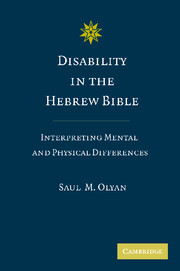Description
Disability in the Hebrew Bible
Interpreting Mental and Physical Differences
Author: Olyan Saul M.
This book seeks to reconstruct the Hebrew Bible's ideas of mental and physical disability and their social ramifications.
Language: English
Subject for Disability in the Hebrew Bible:
Approximative price 49.66 €
In Print (Delivery period: 14 days).
Add to cart
Disability in the Hebrew Bible
Publication date: 07-2012
Support: Print on demand
Publication date: 07-2012
Support: Print on demand
Approximative price 93.25 €
Subject to availability at the publisher.
Add to cart
Disability in the hebrew bible: interpreting mental and physical differences
Publication date: 05-2008
202 p. · 15.8x23.3 cm
Publication date: 05-2008
202 p. · 15.8x23.3 cm
Description
/li>Contents
/li>
Mental and physical disability, ubiquitous in texts of the Hebrew Bible, here receive a thorough treatment. Olyan seeks to reconstruct the Hebrew Bible's particular ideas of what is disabling and their potential social ramifications. Biblical representations of disability and biblical classification schemas - both explicit and implicit - are compared to those of the Hebrew Bible's larger ancient West Asian cultural context, and to those of the later Jewish biblical interpreters who produced the Dead Sea Scrolls. This study will help the reader gain a deeper and more subtle understanding of the ways in which biblical writers constructed hierarchically significant difference and privileged certain groups (e.g. persons with 'whole' bodies) over others (e.g. persons with physical 'defects'). It also explores how ancient interpreters of the Hebrew Bible such as the Qumran sectarians reproduced and reconfigured earlier biblical notions of disability and earlier classification models for their own contexts and ends.
Introduction; 1. Constructions of beauty and ugliness; 2. Physical disabilities classified as 'defects'; 3. Physical disabilities not classified as 'defects'; 4. Mental disability; 5. Disability in the prophetic Utopian vision; 6. Non-somatic parallels to bodily wholeness and 'defect'; 7. Exegetical perpetuations, elaborations and transformations: the case of Qumran; 8. Conclusion.
© 2024 LAVOISIER S.A.S.




